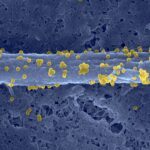Link to Pubmed [PMID] – 24116224
PLoS ONE 2013;8(10):e77320
The Vpr protein from type 1 and type 2 Human Immunodeficiency Viruses (HIV-1 and HIV-2) is thought to inactivate several host proteins through the hijacking of the DCAF1 adaptor of the Cul4A ubiquitin ligase. Here, we identified two transcriptional regulators, ZIP and sZIP, as Vpr-binding proteins degraded in the presence of Vpr. ZIP and sZIP have been shown to act through the recruitment of the NuRD chromatin remodeling complex. Strikingly, chromatin is the only cellular fraction where Vpr is present together with Cul4A ubiquitin ligase subunits. Components of the NuRD complex and exogenous ZIP and sZIP were also associated with this fraction. Several lines of evidence indicate that Vpr induces ZIP and sZIP degradation by hijacking DCAF1: (i) Vpr induced a drastic decrease of exogenously expressed ZIP and sZIP in a dose-dependent manner, (ii) this decrease relied on the proteasome activity, (iii) ZIP or sZIP degradation was impaired in the presence of a DCAF1-binding deficient Vpr mutant or when DCAF1 expression was silenced. Vpr-mediated ZIP and sZIP degradation did not correlate with the growth-related Vpr activities, namely G2 arrest and G2 arrest-independent cytotoxicity. Nonetheless, infection with HIV-1 viruses expressing Vpr led to the degradation of the two proteins. Altogether our results highlight the existence of two host transcription factors inactivated by Vpr. The role of Vpr-mediated ZIP and sZIP degradation in the HIV-1 replication cycle remains to be deciphered.


